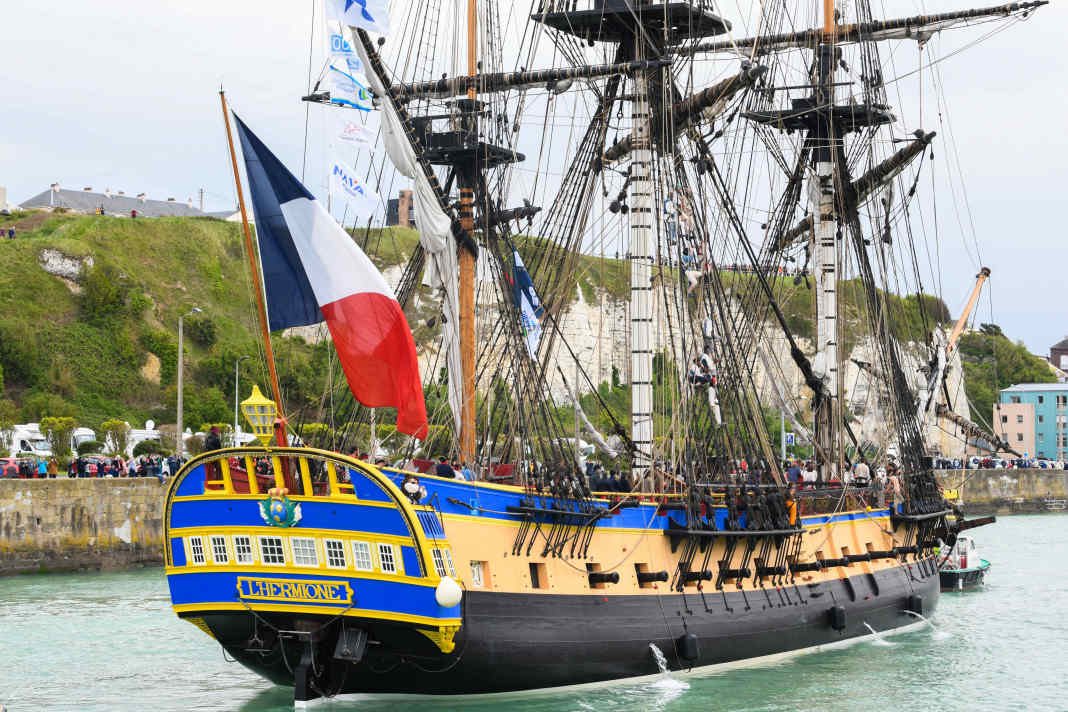





The frigate "L'Hermione" is facing an uncertain future. The commercial court in La Rochelle has placed the operating association Hermione-La Fayette under judicial reorganisation. The operator of the historic three-master, which is struggling with technical problems, now has four to six months to stabilise its financial situation and present a viable rescue plan. The decision raises questions about the long-term viability of this important maritime cultural project.
The frigate "L'Hermione"
The "L'Hermione" is a 65 metre long 32-gun Concorde-class frigate that was completed in Rochefort in 2014. It is a faithful reproduction of the "L'Hermione" from 1779, which became famous when it took General La Fayette across the Atlantic in 1780 to fight on the side of the Americans in the American War of Independence.
The "L'Hermione" Lafayette Association was founded in 1992 by a group of maritime history enthusiasts. Construction began in Rochefort in 1997 and was largely carried out using traditional shipbuilding techniques. After its completion, the "L'Hermione" undertook several symbolic voyages, including an Atlantic crossing to America in 2015, retracing Lafayette's historic path. The ship became an ambassador of French history and craftsmanship, attracting hundreds of thousands of visitors during its harbour visits. This cultural and historical significance would make the potential loss of the ship particularly painful for the maritime community and heritage enthusiasts.
Fight against fungal infestation
During an inspection in 2021, extensive damage caused by rot was discovered on the planking of the "L'Hermione". Repairing the damage requires a complete rebuild, which should be completed this year. The frigate is affected by two fungi that cause rot, Porling and Lenzites, particularly in the stern area. Seven per cent of the wooden structure needs to be replaced. This corresponds to a volume of 40 cubic metres of wood. For reasons of cost and better resistance, moulded wood is to be used instead of solid wood. However, due to a lack of funds, the work had to be cancelled for the time being.
Financial crisis
The costs for maintenance, repair and ongoing operation of the historic replica far exceed the income that can be generated through tours and public events. The association has already had to rely on donations and public funding several times in the past to ensure the preservation of the ship. The cost of the refurbishment is estimated at ten million euros, with the original construction costing 25 million euros. Only around half of the funds required for the renovation have been raised so far.
Judicial supervision
On 18 September 2025, the Commercial Court in La Rochelle announced the opening of judicial reorganisation proceedings for the Association Hermione-La Fayette. The association has now been granted an initial observation period of four months, which can be extended to six months if necessary. During this period, a viable solution to the financial problems must be found. The decision follows a hearing in the insolvency proceedings, which took place at the beginning of September and the outcome of which was officially announced on 22 September.
A trustee and an insolvency administrator have been appointed by the court, who are now auditing the books and overseeing the management of the organisation. This measure is intended to ensure that the available funds are utilised optimally and that no further financial obligations are entered into that could exacerbate the situation. For the association's employees, this means a period of great uncertainty. Salaries for September will be covered by the AGS (Assurance de garantie des salaires), an organisation designed to protect employees if the employer no longer has sufficient funds.
Contradictory communication
The organisation's official communication stands in stark contrast to the reality of the situation. While the published press release emphasises the continuity of the "Hermione adventure" and exudes confidence, the actual situation is much more worrying. The court-ordered reorganisation is a clear sign that the project is no longer in a position to pay its debts in the short term. In order to avoid complete liquidation and save the ship, the organisation must now act quickly and convince partners, local authorities and potential patrons to make a financial commitment.
Various rescue scenarios are conceivable, from increased public funding and private sponsors to a fundamental reorganisation of the operating concept. One possibility would be to integrate the centre into larger tourist or cultural networks in order to exploit synergy effects and increase visitor numbers. Closer cooperation with educational institutions or maritime museums could also open up new sources of funding. The decisive factor will be whether it is possible to develop a sustainable economic model that covers the high operating costs of the historic ship and at the same time fulfils its cultural mission.
The crisis of the "L'Hermione" raises fundamental questions about the preservation of maritime cultural heritage. Historic ships are expensive to maintain and pose major financial challenges for their operators. Similar projects in other countries, such as the "HMS Victory" in the UK or the "Constitution" in the USA, are often financed by a combination of state support, foundation funding and tourism revenue. The fate of the "L'Hermione" could set a precedent for the handling of maritime cultural heritage in France and beyond.
Technical data of the frigate
- Type: Replica of a French frigate from the 18th century
- Year of construction of the original: 1779
- Year of construction of the replica: 1997-2014
- Construction site: Arsenal de Rochefort, France
- Overall length: 65 metres
- Width: 11.24 metres
- Draught: 5.78 metres
- Sailing area: 2,200 square metres
- Number of sails: 19
- Masts: 3 (foremast, mainmast, mizzenmast)
- Crew: 80 people (historically: 200-250)
- Speed: up to 14 knots
- Weight: approx. 1,260 tonnes
- Cannons: 34 replicas of historical guns
- Construction costs: around 25 million euros
- Main building material: oak wood (2,000 oaks were used for the construction)

